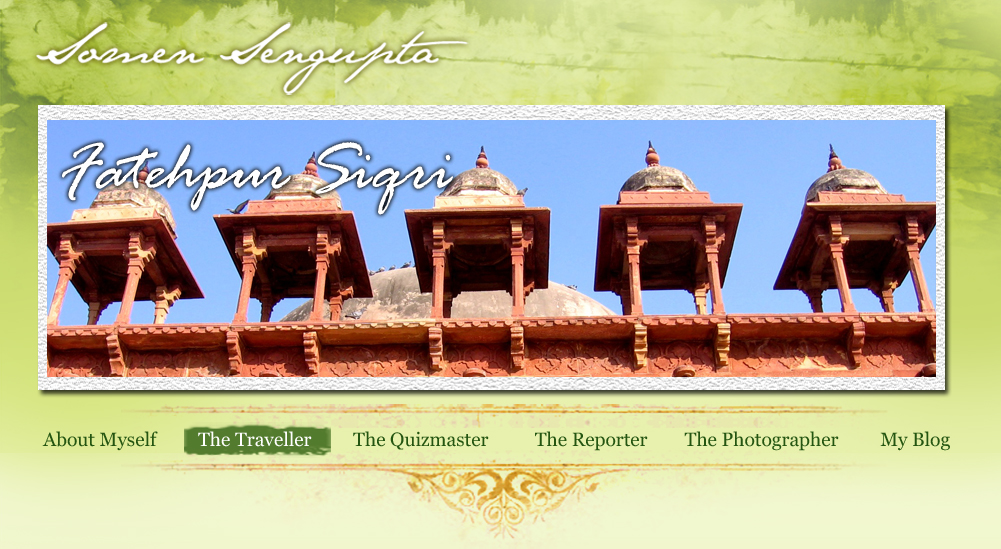|
Fatehpur Sikri might not have fully enjoyed its position as the capital of Mughal empire, but its architectural grandeur still mesmerises all. There’s something about this place that doesn’t allow time to rob it of its magic, writes Somen Sengupta.
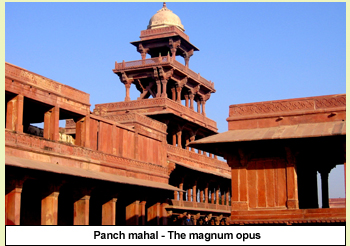
If one goes through the detailed chronology of Islamic rule in India, he/she will come across several archeological marvels, each more astounding than the other. In this rich archeological heritage, there is one 450-year-old magnum opus that still stands tall. Fatehpur Sikri refers to a town in the Agra District. It was founded by Mughal emperor Akbar as the capital city of his empire. The monument that is metonymously referred to by the same name is so beautiful that it still manages to amaze tourists.
Even though Fatehpur Sikri is largely associated with Akbar, this place was first named by his grandfather Babur. Babur had named a village Shukhria. This name transformed into Sikri in common parlance and around the 16th century, it gained popularity as the place where Salim Chisti, a Sufi saint, used to stay. Legend has it that Akbar sought this saint’s blessing in order to have a male child. The emperor had been childless for a long time. The prophecy of Salim Chishti worked like magic and Akbar’s third wife, who was a Rajput princess, became pregnant. The grateful king took his pregnant wife to the village of Sikri. The royal couple had a son on August 30, 1569. Akbar named the child Salim after the saint who had made his birth possible. Soon, Akbar was blessed with two more sons from his two other wives. One son was born in 1570 and another in 1572. As a gesture of his gratitude, Akbar decided to set up his new capital in the village of Sikri.
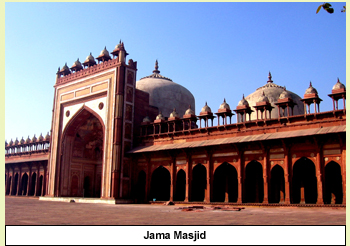 So, a huge construction project was undertaken on the rocky ridge of a dusty village in 1569. The material used for this was high quality red sand stone that still shines on every wall. The design of this Indo-Islamic masterpiece included a royal court, pavilions, gardens, palaces, entertainment arena, mosque, majestic gates, zone for games and amusement, residential apartments and, needless to say, provision for religious activities. Researchers argue this was the first planned city of Mughal India. It was imagined and executed at a phenomenal speed. And the result turned out be the perfect combination of intense emotion and effort. So, a huge construction project was undertaken on the rocky ridge of a dusty village in 1569. The material used for this was high quality red sand stone that still shines on every wall. The design of this Indo-Islamic masterpiece included a royal court, pavilions, gardens, palaces, entertainment arena, mosque, majestic gates, zone for games and amusement, residential apartments and, needless to say, provision for religious activities. Researchers argue this was the first planned city of Mughal India. It was imagined and executed at a phenomenal speed. And the result turned out be the perfect combination of intense emotion and effort.
What we today know as the monument of Fatehpur Sikri can be divided into three parts — section for religious practices, administrative section, and private residential section. The three-km-long and one-km-wide city is surrounded by a six-km wall on three sides. The entry passage is decorated with several majestic gates named as Delhi Gate, Lal Gate, Chandanpal Gate, Gwalior Gate, Ajmer Gate, and Tehra Gate.
It all started with construction of a massive mosque which was completed between 1571 to 1572. Known as Jama Masjid, this 540-ft-long mosque is one of the biggest mosques in India. Still in use, the mosque houses a massive congregational space and a central courtyard. The domes are made of marble with a chhatri (umbrella-like structure) decorated over sanctuary. Like most of the other monument in Fatehpur Sikri, this too reflects strong Hindu influence in its design, especially the domes.
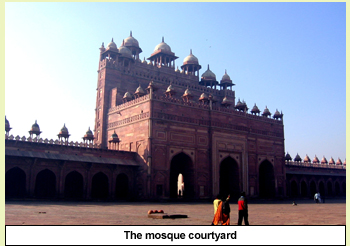 At the courtyard of the mosque stands the grave of Salim Chishti (1478-1572 ) which is a pure marble tomb deeply influenced by the 15th century Gujarat sultanate school of architecture. The marvellous work on marble with serpentine brackets that covers the entire tomb is breathtaking. The brackets looks like English alphabet “S”. They have been decorated with floral design that hold the running marble canopy. Even the rain water drainage system of the tomb is so modern that it has the provision of passing water directly from the roof to the underground level through a hollow pillar. The tomb is still counted a sacred place for childless couples who come here for blessings. At the courtyard of the mosque stands the grave of Salim Chishti (1478-1572 ) which is a pure marble tomb deeply influenced by the 15th century Gujarat sultanate school of architecture. The marvellous work on marble with serpentine brackets that covers the entire tomb is breathtaking. The brackets looks like English alphabet “S”. They have been decorated with floral design that hold the running marble canopy. Even the rain water drainage system of the tomb is so modern that it has the provision of passing water directly from the roof to the underground level through a hollow pillar. The tomb is still counted a sacred place for childless couples who come here for blessings.
In 1573, Akbar’s conquest of Gujarat gave a new gem to this city. Akbar added the word Fatehpur meaning the “city of victory” to the word Sikri. To commemorate the victory, a 176-ft-high Buland Darwaza was added to the structure. It replaced an existing gate on the south of the courtyard of the mosque.
The idea behind this was to make the structure accessible through a grand number of stairs from a lower slope. Upon climbing them, one would see a gate so massive that it will leave a lasting impression. The intention was that the impact would combine three different rasas or themes. These included the Bhayanak Rasa that would generate a sense of fear — at a glance, the front of the gate looks like a demon with its mouth wide open. Veer Rasa was supposed to be the second theme — parts of the gate are designed like a regal crown. Shanta Rasa was supposed to be third theme as one idea behind such a grand gate was to remind human beings of the massiveness of almighty. The side and top panels the gate are embellished with quotes from the Quran.
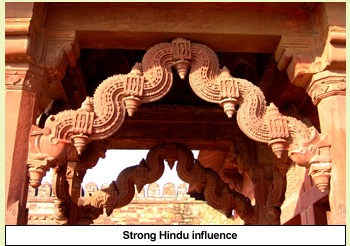 Fatehpur Sikri also houses Diwan-i-Khas and Diwan-i-Am. The former boosts of a rather unique architectural design where a central pillar made of red sand stone is very richly designed in a blending of Hindu and Islamic motifs. The design expands on top to make a provision of a royal seat which is reachable from four elevated pathways. The pillar is square at the base. The crowning of the pillar is expanded with several layers of decorated brackets. It seems that the members of court had their seats on the ground floor. There is a hanging balcony on the second floor. The multi-religious influence has led certain groups of historians to believe that Akbar used to discuss religious texts here. Fatehpur Sikri also houses Diwan-i-Khas and Diwan-i-Am. The former boosts of a rather unique architectural design where a central pillar made of red sand stone is very richly designed in a blending of Hindu and Islamic motifs. The design expands on top to make a provision of a royal seat which is reachable from four elevated pathways. The pillar is square at the base. The crowning of the pillar is expanded with several layers of decorated brackets. It seems that the members of court had their seats on the ground floor. There is a hanging balcony on the second floor. The multi-religious influence has led certain groups of historians to believe that Akbar used to discuss religious texts here.
Diwan-i-Am is a simple, square-shaped, double-storied building in a garden. There are five rooms on the second floor and a hanging chamber in Rajasthani jharokha style which was the seat of Emperor. From this royal seat he used to address his subjects. At the North-West corner of this chamber, a big iron ring can still be seen. It is believed that a royal elephant would be tied up here when the court was in session. The elephant would be assigned the task of executing death penalty.
Badshahi Hammam and Anup Talao are two closely situated monuments in this area. The former is nothing but the royal bath with a unique system for the supply of hot and cold water circulation. This place also includes oil massage room, changing room, toilets, and water tubs. A unique system for capturing natural light was also used here.
Anup Talao is a water reservoir that has an open, decorated seat at its centre. The seat is bridged with a narrow walkway. It is encircled with a beautiful stone railing on all four sides. It is believed that two legendary musicians from Akbar’s court — Tansen and Baiju Bawra — used to perform here.
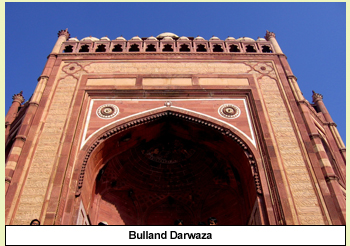 The royal bedroom is known as Khwabdaha. This special room houses a high legged big stone bed which used to be climbed with a flight of stairs. There was a provision to fill the floor with cold water that used to keep the room cool. The room had secret connectivity with the Begum Mahal and that path was once covered with especially designed stone curtains. The royal bedroom is known as Khwabdaha. This special room houses a high legged big stone bed which used to be climbed with a flight of stairs. There was a provision to fill the floor with cold water that used to keep the room cool. The room had secret connectivity with the Begum Mahal and that path was once covered with especially designed stone curtains.
Several other majestic palaces in this part of Fatehpur Sikri are mingled with legend, folklore and history. Often, it becomes difficult from people to differentiate between these and authentic history. One such palace is Jodha Bai Mahal, the palace of Akbar’s chief queen Jodha Bai. Interestingly, historians argue that Akbar was never married to any such Rajput lady who bore him a son. Another such disputed palace here is Birbal palace — home of Akbar’s favourite Hindu court royal. It is located inside the zone where Akbar’s harem is located. But again, historians argue, why would a Hindu male be allowed to live in the emperor’s harem?
Moving on, another such palace is called Sunehra Makan. This palace is believed to have been habited by Akbar’s mother Hamida Banu, also known as Mariam Makani. But other versions suggest rear this was in fact the palace of Akbar’s Goan wife, Mariam.
Nauroz Bagicha or the royal garden was once the place for a weekly bazaar organised by female members of royal family. Some even argue that this was where Jahangir and Noor Jahan had first met.Other minor monuments of Fatehpur Sikri include Rang Mahal, Kabutar Khana, Hathi Pole, Sangin Burj, Hiran Minar, and Karawan Sarai.
Political upheaval after 1585 kept Akbar busy in Lahore of Punjab. Around 1599, when he did come back to Fatehpur Sikri, it was suffering from acute crisis of water and its population had declined. Eventually, Akbar shifted his power centre to Agra.
Soon after that, Fatehpur Sikri became a ghost town. By end of the 17th century, it was completely abandoned and banished into oblivion. It was Lord Curzon who took the initiative to restore and salvage the place. In 1986, the place was declared a UNESCO world heritage site. Clearly, there is something about this place that doesn’t allow even time to rob the monument of its magic.
This article was published in The Pioneer on 17th March 2019.
Click here to view the original article
|
